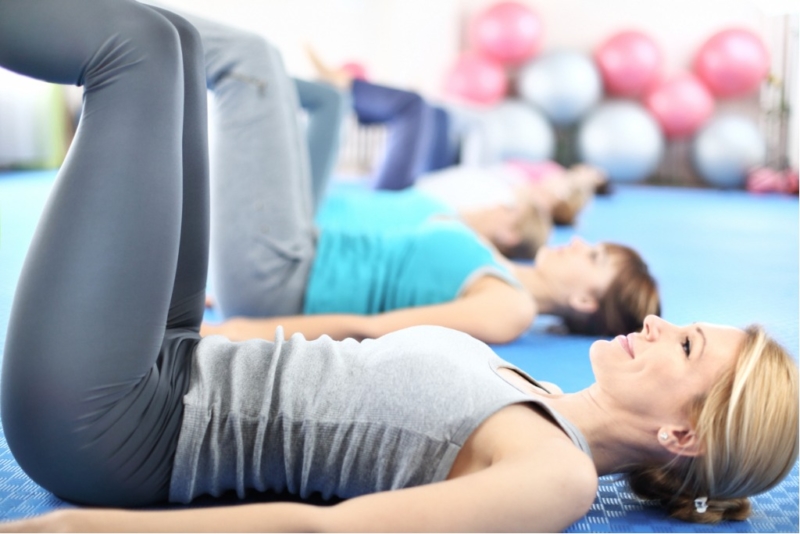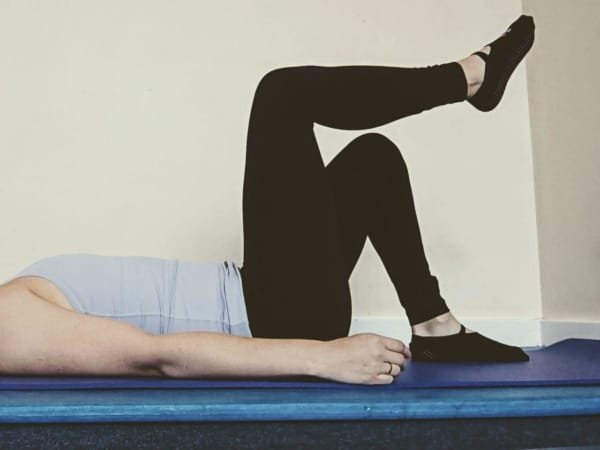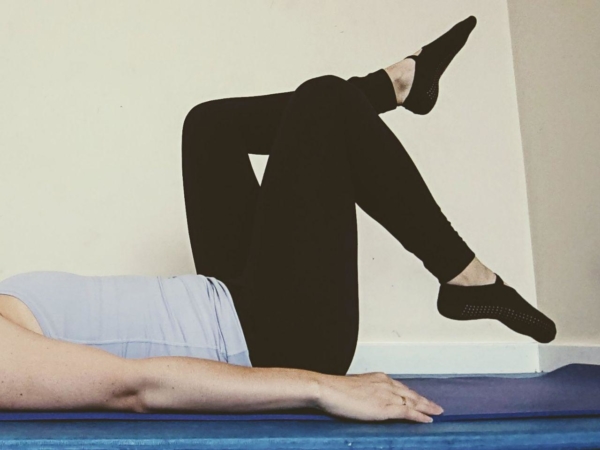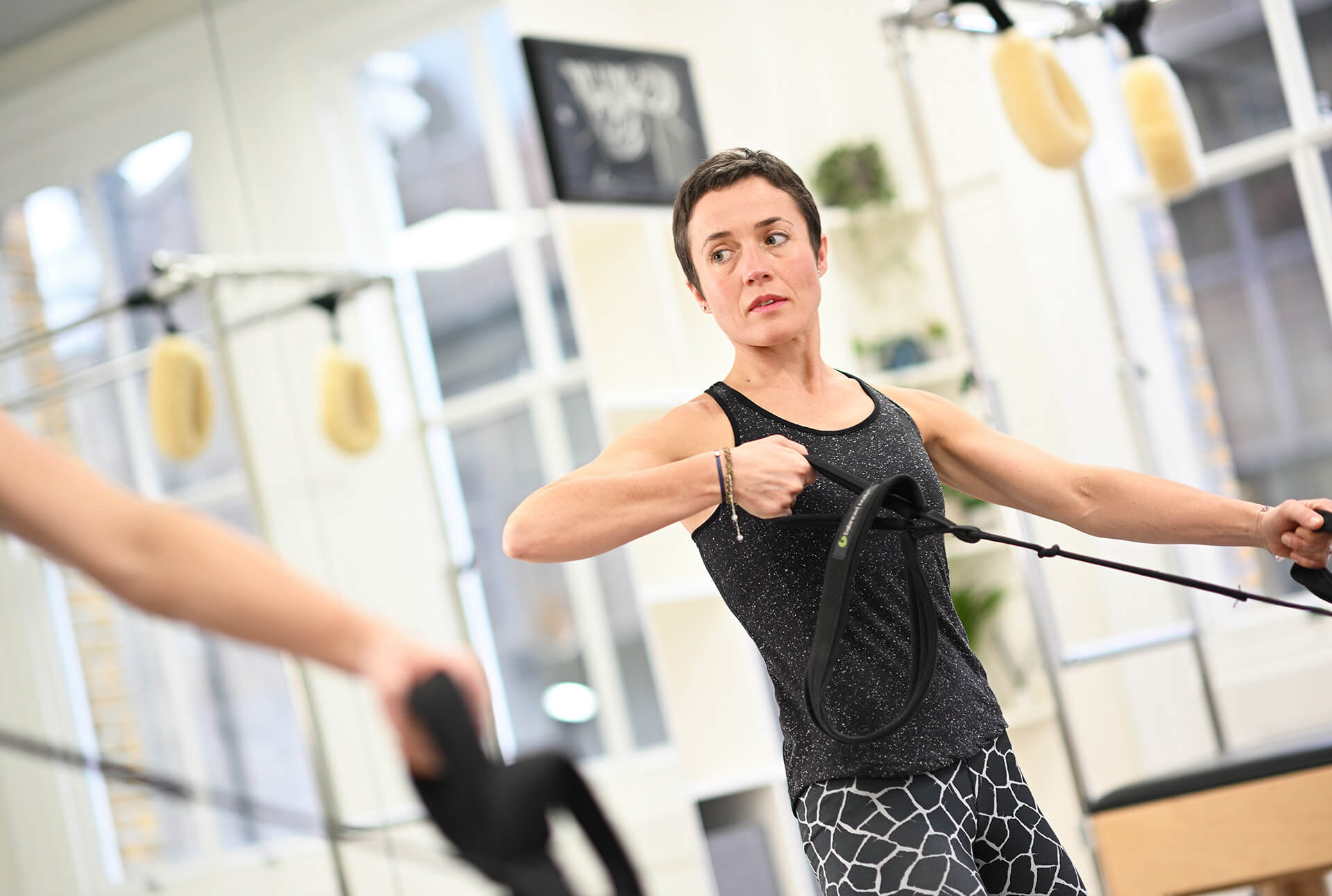Lower Ab Exercises – Your lower abdominals can be a tricky area to train and tend to get neglected in many of the usual ab strengthening exercises.
But failing to target this area can do more than merely deprive you of flat abs. Doing so means that the Transverse Abdominis (TVA), the deepest lower abdominal muscle, isn’t getting the attention it needs.
Why is the TVA important? Well, this muscle stabilises and supports the spine and pelvis. This protects your discs and joints from injury.
To target this area, choose controlled moves (like the dead bugs and femur arcs exercises shown here) that isolate the lower abs.
These low ab Pilates exercises are great for almost everyone and are a safer choice than more dynamic moves (like reverse abs on the stability ball) for beginners or when recovering from an injury.
Equipment:
- A mat.
- A pillow (optional).
Lower Ab Pilates Exercises
Variation 1: Dead bugs
Starting position:
- Lie on your back with your feet flat on the floor and knees bent.
- Ideally, legs should be hip distance apart.
- Your head can be propped up on a pillow if that feels more comfortable, or if you notice your ribs flaring.
- Arms down by your sides and relaxed. Palms can be facing up or down.
- Spine is in neutral – so check that you can feel that natural tiny gap behind your lower back and the mat is there.
The exercise:
- Take an inhale to prepare.
- On the exhale, lift one leg up to table top. This is a Pilates term for when the thigh bones are perpendicular to the floor and shins are parallel to the floor.
- Exhale as you lower the leg.
- Repeat on the other side.
Top tips:
- Try to move the legs with as little effort as possible. To do this, relax your bottom. Then, as you bring the leg into the table top position, imagine the thigh bone is filling with concrete as you “pour” (drop) the hip into the socket.
- The front of your hip should remain soft during the exercise.
- It can also help to press firmly on the foot still on the mat to allow the other leg to become light and to “float” up to the table top position.
- Keep the pelvis still and in neutral throughout the movement.
- Avoid using your neck or tensing your shoulders.
Repeat between 5 – 10 times. Focus on maintaining good form throughout and stop if you feel you’ve lost this.
Variation 2: Femur arcs
This exercise is a progression from dead bugs and because of this is a bit more challenging for those lower abdominals.
Starting position:
- Lying on your back with a pillow behind your head if you like.
- Arms down by your sides and relaxed, palms can be facing up or down.
- Spine is in neutral.
- Inhale deeply.
- On the exhale bring one leg and then the other up to the table top position.
The exercise:
- Inhale to prepare.
- On the exhale, move from your hip and lower one leg towards the floor until your toe just touches the mat.
- Inhale to return the leg and then repeat on the other side.
Top tips:
- Watch for doming of the abdominals as you lower your leg towards the ground. This is when the abs “pop up” and is a sign that they are weak and can lead to back pain. To prevent doming, reduce your range of movement and only send your leg towards the ground to the point where your abdominals can stay flat. Then bring the leg back.
- Check that your hips aren’t rotating or that your lower back isn’t arching or flattening. Your spine should stay in neutral throughout this exercise.
- Allow your legs to roll freely in their sockets as you lift your legs.
- Use imagery: picture balloons attached to your knees. Then imagine the legs floating back up to the table top position, supported by the balloons. This should help the movement feel quite effortless.
Repeat between 5 – 10 times. Focus on maintaining good form throughout and stop if you feel you’ve lost this.
Benefits:
Working the lower abs in this way is an effective way of functionally activating the TVA.
People often talk about strengthening the TVA – but you can’t actually strengthen it. Instead, by performing exercises on this area you teach it to switch on to stabilise and protect the spine as and when it needs to.
This is also important for those of us looking for flatter abs and are unable to achieve them through diet and the usual ab exercises.
This is because a bulging waistline can sometimes be the result of weak deep abdominal fibres. And, while it may seem surprising, even people who appear strong and work out regularly with weights can suffer from this. If this is you, then you need to start paying attention to those deep abs!
On top of all this, performing dead bug and femur arcs regularly help you to develop better control over your torso. They teach you to move your hips independently of your pelvis.
This latter benefit isn’t talked about much in fitness circles. Being able to move your legs freely in the hip sockets without twisting the pelvis or torso unnecessarily is really important. This is because moving in this way protects the spine and joints. It also makes your movement more efficient. You’ll feel the benefits of this in everything from simply standing up from a chair to squatting at the gym.
Build up to:
You can also use this exercise as a preparation for more advanced exercise in the gym, (like squatting heavy weights) or in Pilates itself. Like abdominal work on the reformer.
To make this exercise more challenging, we suggest placing a foam roller or soft ball behind your pelvis. Try the dead bugs and femur arcs from this position.
Once you’ve mastered this then why not try reverse abdominals on the stability ball.
If you enjoyed this then why not try the basic Pilates bridge exercise or this simple spine mobilisation exercise.
Education is key:
These blogs are designed to give information to everyone, however, it is important to remember that everyone is different! If you have not seen one of our therapists and have any questions about injuries, what you have read or whether this may be useful to you, please just ask. We are more than happy to help anyone and point you in the right direction. Our biggest belief is that education is key. The more you understand about your injury, illness and movement, the more you are likely to improve.









Leave a comment